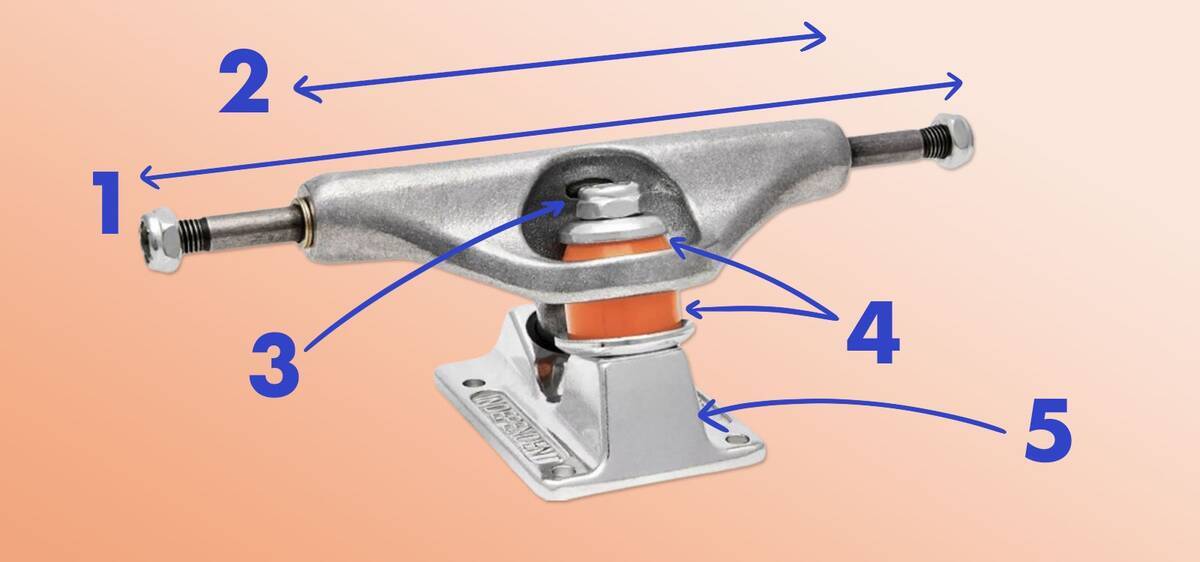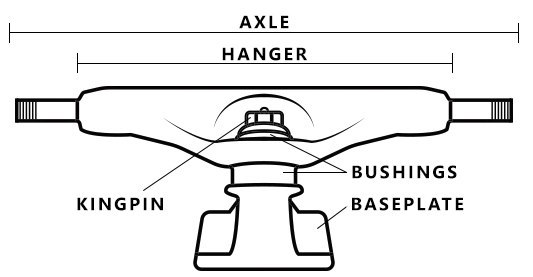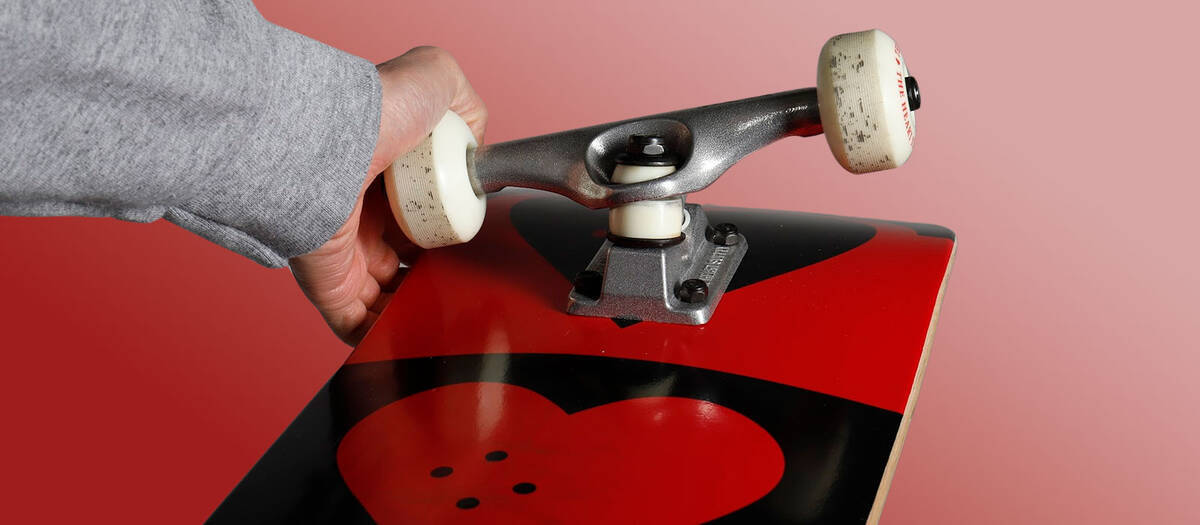Guide to Buying Skateboard Trucks
Choosing the right skateboard trucks can be challenging. Generally, if you go with a reputable manufacturer and ensure your chosen size matches your deck, you're likely to be satisfied with your purchase. When you get a complete skateboard, the trucks are pre-installed and perfectly sized for the setup.
Overview
Understanding the Parts of a Skateboard Truck

Before delving into specifics, let's look at the basics. What are skateboard trucks? Essentially, trucks are the T-shaped metal components attached to the underside of your skateboard deck. They hold the wheels and consist of two main parts that rotate, or pivot, against each other: the baseplate and the hanger. These are secured by a bolt—known as the kingpin—which also holds the bushings. Here's a breakdown of the main parts of a skateboard truck:
Baseplate
The baseplate is the flat metal piece affixed directly to the deck with 4 bolts. Its role includes even weight distribution across the entire truck to ensure stability, and it equally spreads the impact of landings to the deck. The pivot cups, integral for the hangers’ pivoting capability and smoothness of turns, are located in the baseplates. Acting as a direct link between the deck and the hanger, the baseplate is essential to both the truck and your overall setup.
Hanger
The truck hanger is the largest part of a skateboard truck. It is an oblong metal piece that forms a triangular shape towards the pivot, fitting into the pivot cup within the baseplate. Hangers, which grind directly on rails, copings, and ledges, are crucial for performing grind tricks.
Axle
The wheel axle runs through the inside of the hanger and features threading on both ends, where nuts fasten the wheels. Over time, especially if frequent rail stands occur, the outer threads may wear down, but they can be repaired using proper tools. Many T-tools come with 5/16" axle re-threaders. If you have previously needed to repair axle threads, a skate tool with a re-threader can be quite useful. Check our selection for one:
Kingpin
The kingpin is a substantial bolt passing through the middle of the truck, holding the various components together. By adjusting the kingpin nut, you can modify the tightness of your trucks. While kingpins can break under pressure, they can be replaced if necessary.
Truck Bushings
Bushings are the rubber-like cushions positioned between the baseplate and the hanger. They facilitate the transfer of pressure from your feet to the hangers, thus affecting the agility of your setup. Bushing firmness influences your turning ability:
- Hard bushings: Make the trucks stiffer and more stable, ideal if the trucks wobble. Hard bushings require more effort to initiate turns.
- Soft bushings: Perfect for carving and cruising, and for skaters who enjoy the responsiveness of loose trucks.
Discover how to install skateboard bushings or find new bushings, washers or hardware here:
Now that you understand the parts that make up a skateboard truck, let's delve into what you need to consider to choose the perfect trucks for your setup.
Determining Skateboard Truck Sizes & How to Measure Them

Skateboard trucks come in different sizes, defined by width and height. Here is a brief introduction that will assist you in determining the suitable size for your skateboard trucks.
Skateboard Truck Width

It's crucial to match your truck's width with that of your deck. A mismatch in truck and deck width can lead to instability with narrow trucks or interference from wider trucks when executing certain movements. Oversized trucks can also complicate executing flip tricks. Skateboard brands specify truck sizes by referring to hanger width but exclude axle width. However, you need to match the overall width, including the axles, with your deck’s width.
At SkatePro, we list the axle width of each truck, so you won’t need to consult a size chart that converts manufacturer sizes to inches.
Skateboard Truck Height

Truck height signifies the space between the baseplate and the axle centers. It defines how far the deck sits from both the wheels and the ground. When choosing truck height, consider the deck-to-wheels and deck-to-ground distances.
Trucks typically come in high, medium, or low profiles:
- Low Trucks (46-49 mm): Positioned closer to the ground, these are easier for kids, beginners, and shorter individuals to manage due to the increased stability. Avoid using wheels over 53 mm without risers, as they increase wheel-deck clearance!
- Mid Trucks (49.5-53.5 mm): These form a middle ground between high and low trucks. For those using wheels over 56 mm, adding risers is advisable.
- High Trucks (53.5-60mm): A setup with high trucks provides the ability to fit larger wheels and offers room for cruising and carving due to ample desk-to-wheel clearance. High trucks are also advantageous for freestyle skateboarding, offering broader platforms for balance.
We always specify truck height in our product specifications.
Considerations for Choosing Skateboard Truck Height
Truck height is mostly about personal choice, influenced by your style and physical attributes. Key factors to consider include:
- Wheel clearance: This is the gap between the wheels and deck, determined by wheel diameter and truck height. If you prefer carving or deep turns, you need more clearance than someone who opts for stable, tight trucks.
- Pop angle: The distance between trucks alters the pop angle, affecting how easily the board leaves the ground during tricks. Low trucks offer a quick response, whereas high trucks, offering more leverage, assist with "bigger" tricks.
- Pushing: Higher trucks create more distance between your pushing and deck foot, making it less comfortable for extended distances.
- Tricks: Truck height affects the ease or difficulty of specific tricks. High trucks offer larger platforms for balancing, while low trucks enhance flick tricks' agility.
- Truck weight: Generally, the larger the truck, the heavier it is.
- Personal height: Taller people can more easily manage high trucks than those with shorter legs.
Adjust Truck Height with Riser Pads to Avoid Wheel Bite

Riser pads are an effective and economical solution for skateboarders experiencing wheel bites, which happen when wheels hit the deck during tight turns. By increasing the distance between the deck and wheels, riser pads prevent these encounters.
If you're experimenting with larger wheels or loosening your trucks, riser pads may prove invaluable.
For skateboarders interested in preventing wheel bites or refining their setup, exploring our range of riser pads is worthwhile:
Ensure that you use the correct hardware for installing riser pads. Our guide can help if you're unsure about bolt lengths:
Considering Skateboard Truck Weight: Heavy vs. Light Trucks
Trucks account for a substantial part of your skateboard's total weight. Many modern skateboard truck innovations strive to reduce this. Hollow kingpins and axles or alternative materials are just some techniques employed to lessen their mass.
Currently, the "lightest trucks ever," the Tensor Mag Light Series, indeed top the market in terms of weight reduction. For trick execution, lighter trucks provide an edge, though you might not notice weight disparities as much as other truck traits.
Remember, the weight of your trucks is directly linked to their size. A taller, wider truck will weigh more than a shorter, narrower one. A truck's weight should be considered alongside wheel diameter and deck width.
Adjusting Skateboard Truck Tightness: Loose or Tight?

Adjusting your skateboard trucks can be done using the kingpin nut with a skate tool, standard wrench or spanner. If you tighten the nut, more effort will be needed for turns, whereas loosening will make it easier to turn. Looser trucks provide flexibility and responsiveness, while tighter ones offer greater stability. The ideal truck tightness is dependent on personal style and preference.
Finding the perfect balance between tight and loose trucks affects the skateboard's turning ability. It often takes time and experimentation to find your preferred setting. Make sure to keep your skate tool handy during sessions to try out varying settings.
Tighten your trucks if:- Wheel bites occur when turning or after landing tricks.
- You're seeking a more predictable pop.
- The board feels unstable at high speeds or upon landing.
- You notice you're lifting the front wheels to steer.
- You desire sharper turns.
- You feel constrained and seek more flexibility to shift from side to side.
Turning and carving are influenced by the firmness of your bushings. Bushings come in varying levels of firmness, usually evaluated on the durometer scale. A higher durometer indicates harder bushings – with harder bushings resulting in tighter trucks. Explore our range of bushings:
The Process of Fitting Skateboard Trucks
To fit the trucks, you need 4 nuts & 4 bolts per truck. We suggest tightening the bolts in a cross-diagonal manner to ensure the baseplate is equally tightened on the surface.
We are always prepared to assist:
